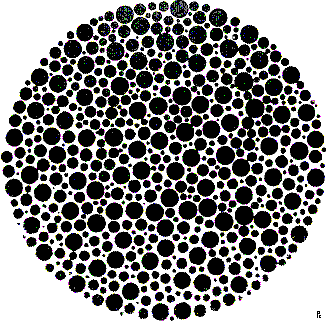
Ishihara color test
Encyclopedia
The Ishihara Color Test is an example of a color perception test for red-green color deficiencies
. It was named after its designer, Dr. Shinobu Ishihara
, a professor at the University of Tokyo
, who first published his tests in 1917.
The test consists of a number of colored plates, called Ishihara plates, each of which contains a circle of dots appearing randomized in color and size. Within the pattern are dots which form a number visible to those with normal color vision and invisible, or difficult to see, for those with a red-green color vision defect. The full test consists of 38 plates, but the existence of a deficiency is usually clear after a few plates. Testing the first 24 plates gives a more accurate diagnosis of the severity of the color vision defect.
Common plates include a circle of dots in shades of green and light blues with a figure differentiated in shades of brown, or a circle of dots in shades of red, orange and yellow with a figure in shades of green; the first testing for protanopia and the second for deuteranopia.

Color blindness
Color blindness or color vision deficiency is the inability or decreased ability to see color, or perceive color differences, under lighting conditions when color vision is not normally impaired...
. It was named after its designer, Dr. Shinobu Ishihara
Shinobu Ishihara
was a Japanese ophthalmologist who created the Ishihara color test to detect colour blindness.-Early life and career:Shinobu graduated from medicine in 1905 on a military scholarship and immediately joined the army as a doctor, serving mainly as a surgeon...
, a professor at the University of Tokyo
University of Tokyo
, abbreviated as , is a major research university located in Tokyo, Japan. The University has 10 faculties with a total of around 30,000 students, 2,100 of whom are foreign. Its five campuses are in Hongō, Komaba, Kashiwa, Shirokane and Nakano. It is considered to be the most prestigious university...
, who first published his tests in 1917.
The test consists of a number of colored plates, called Ishihara plates, each of which contains a circle of dots appearing randomized in color and size. Within the pattern are dots which form a number visible to those with normal color vision and invisible, or difficult to see, for those with a red-green color vision defect. The full test consists of 38 plates, but the existence of a deficiency is usually clear after a few plates. Testing the first 24 plates gives a more accurate diagnosis of the severity of the color vision defect.
Common plates include a circle of dots in shades of green and light blues with a figure differentiated in shades of brown, or a circle of dots in shades of red, orange and yellow with a figure in shades of green; the first testing for protanopia and the second for deuteranopia.

External links
- Ishihara color test information
- The Ishihara Color Blindness Test
- Test of color blindness with the indication of the weaknesses in various colours, quantifies green red blue deficiency (ISHIHARA test alternative)
- Flash animated Ishihara color blindness test

